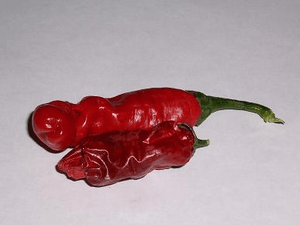Peter pepper facts for kids
Quick facts for kids Peter red pepper |
|
|---|---|

Mature Peter red chili next to a dried pod
|
|
| Species | Capsicum annuum var. annuum |
| Heat | |
| Scoville scale | 10,000-23,000 SHU |
The peter pepper is a very unique type of chili pepper. It is famous for its unusual shape, which looks a bit like a certain body part! This pepper is a kind of Capsicum annuum, which is the plant family that most common peppers belong to. It's considered an heirloom plant, meaning its seeds have been passed down through generations.
You can find peter peppers in red and yellow colors. They are quite rare, and nobody knows exactly where they first came from. These peppers are mostly grown in places like East Texas, Louisiana, and parts of Mexico.
A journalist named Frank X. Tolbert helped make the peter pepper well-known in the United States. He wrote about it in his newspaper column for the Dallas Morning News. Even though he only saw the pepper once, his stories made people curious! Experts at the University of Texas at Austin and Louisiana State University have even studied this interesting pepper.
Even though it's rare, you can sometimes find seeds for peter peppers from special suppliers. They can grow well in many different places. Some seeds have even been sent to countries in Asia, like South Korea.
The peter pepper pod looks a bit wrinkled. It has a round tip with a small split in it. When it's fully grown, it's usually about 3 to 4 inches long and 1 to 1.5 inches wide. This pepper is also known for being quite spicy.
Because it's so spicy, with a high Scoville scale rating, the peter pepper is often grown more for its cool look than for eating. However, some people do enjoy pickling it.
Growing Peter Peppers: A Fun Project
Want to try growing your own peter peppers? It can be a fun project! A gardening expert, Alice Brantley Yeager, shared some tips in Backwoods Home Magazine.
Best Conditions for Peter Peppers
- Sunny Spot: Peter peppers love sunshine. Pick a place in your garden that gets lots of sun.
- Good Soil: The soil should be moderately rich. This means it has enough nutrients for the plant to grow strong.
- Watering: Give your peter pepper plants the same amount of water you would give any other pepper plant. Make sure to water them regularly, especially if it's dry outside.
Starting Your Seeds
It's a good idea to use a "seed starter" to help the seeds sprout. A seed starter is a special tray or kit that gives seeds the best start. If you don't have one, don't worry! You can plant the seeds in a plastic or clay pot. Just make sure to put the pot in a sunny window so the seeds get enough light.

